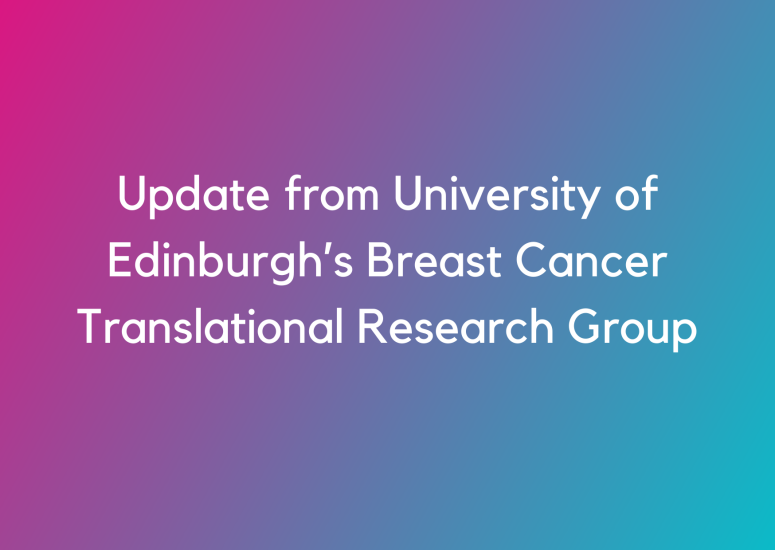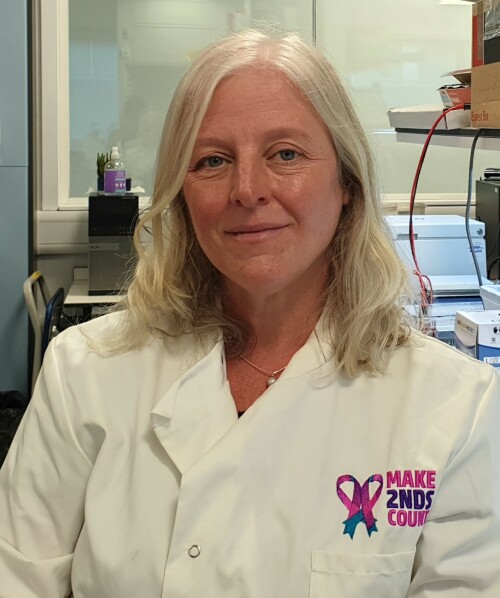20th October 2021


We talked to Fiona Semple, Senior Post Doctoral Fellow, to find out more about the pioneering research project Make 2nds Count is funding with the Edinburgh Cancer Research Centre.
Tell us about your role at the University of Edinburgh’s Breast Cancer Translational Research Group?
By training I am a molecular biologist and have spent many years investigating molecular
changes that occur within human cells. My work in the Breast Cancer Translational Research Group in Dr Oikomomidou’s lab involves designing and implementing assays (tests) to look at these molecular changes in the tumours of breast cancer patients, known as ‘profiling’ tumours. It’s important to profile the tumours of individual patients because over the past 10 years or so it has become clear that tumours with certain features respond better to particular
therapies. By knowing the molecular profile of a tumour we can help patients get the best
possible specific treatment. Patients can then also be monitored by blood tests (known as
liquid biopsy) to monitor progression of a tumour, the effect of treatment and/or recurrence of tumours.
Cancer is often called a disease of the genome (a person’s genetic instructions made of DNA)
because in each tumour the persons DNA has accumulated many thousands of mutations
(changes). The assays I am designing and implementing examine the tumour DNA. In the lab
I receive samples from patients’ tumours, isolate the genetic material, then prepare the
tumour DNA (which involves a multistep procedure) so that it can be read by High
Throughput Sequencing machines. These machines generate millions of DNA sequence
reads, which include the mutations. This data then requires interpretation and analysis
(known as bioinformatics).
Can you explain what the project with Make 2nd Count is about and what you hope to find?
Although tumours share some of their biology, every individual tumour is different from
another, i.e all tumours have different mutation profiles. It is these mutations that determine
how the tumour behaves when treated and underlie the evolution of resistance to a particular
treatment. For example, a tumour with mutations in BRCA1 or BRCA2 may benefit from
treatment with a class of drugs called PARP inhibitors, however for tumours without these
mutations the patient would be stratified for treatment with another medicine. Similarly,
CDK4/6 inhibitors interrupt growth of metastatic breast cancer and our research specifically
aims to identify mutations that increase the likelihood of success with this treatment.
Ultimately what we hope to find is a way to select the best treatment for a patient based on
identifying and monitoring the specific mutations in that patient’s tumour.
Why is this important for secondary breast cancer?
In secondary breast cancer, tumour cells have spread to other parts of the body where they
begin to grow. CDK4/6 inhibitors, which are being successfully used in combination with
endocrine therapy for advanced breast cancers disrupt the way in which these secondary
tumours divide and multiply. However, some patients do not benefit from CDK4/6 inhibitors
and many develop resistance to treatment. Using our assays, we will be able to identify the
genetic changes that are occurring in the tumour cells leading to this resistance.
How far through the project are you? Can you tell us about any findings so far?
I have been in post for exactly one year this month and things are progressing well, despite
the restrictions due to Covid19. We have our lab bench fully functioning with all the
equipment we need in place (or ready to be borrowed!). We also have a PhD student who has
been with us for 9 months now working on some aspects of the project. We also have a
research assistant dedicated to tissue collection and data management of patient outcomes.
So far, we have identified appropriate samples from patients who have and have not developed secondary cancer, this will allow us to look for important differences between these two groups, and we have extracted high quality DNA. Tumour samples have traditionally been
fixed in formalin and stored in paraffin blocks which is very useful for investigating tumour pathology, however obtaining high quality DNA from these stored samples can be challenging. It is important that the DNA for sequencing is of high quality as this provides
the resulting tumour molecular profile. Now that we have DNA from the patient tumours, we
are beginning to prepare the DNA for High Throughput Sequencing (as discussed above). We
also have blood samples from 150 metastatic breast cancer patients and are in the process of
extracting the DNA from these samples to allow us to ultimately develop specific liquid
biopsy assays for continuous monitoring of patients.
In addition, I am working on establishing and optimising an assay, originally developed by
the Karolinska Institute in Stockholm, so that it can be used in a routine way on Dr.
Oikonomidou’s patient’s samples. This assay enables the investigation of tumour mutations
in extremely small amounts of DNA, meaning that many different regions of a tumour can be
profiled at the same time. This will give us an insight into the mutations that may be
developing and evolving at different parts of the patient tumour.
Do you collaborate with other research projects and programmes on the work you are doing?
Yes, collaboration is very important in all aspects of research, from sharing pieces of lab
equipment with other research groups, to the involvement of experts, such as pathologists and bioinformaticians, to assist in the interpretation of data. For example, I am located in a lab
alongside many other researchers working on a variety of different aspects of tumour biology.
This provides an environment for active discussion about experimental procedures and
techniques, and this shared knowledge leads to increased productivity and progress. Also,
because I am implementing an assay in the Edinburgh labs, which was first established at the
Karolinska Institute in Stockholm, this involves many discussions with Karolinska’s expert
scientists. In addition, one of the strengths of working in the IGC is that we have many
groups of computer scientists and statisticians. This is important because when a tumour is
profiled a vast amount of data are generated which consists of the thousands of mutations
seen in each tumour. To understand the importance of these mutations we compare them
across different patient’s tumours. The size of these datasets means that this analysis
(bioinformatics) requires large computing capacity, such as Edinburgh University’s
supercomputing cluster which has specialised software and statistics, all necessary to allow
us to get the in depth analysis of each patient’s tumour to help us find answers.
This combination of the latest lab techniques in molecular biology with cutting edge
bioinformatics puts us in a great position to gain new insights into secondary breast cancer.
Moreover, through Dr Oikonomidou’s involvement as a clinical trialist, leading national and
international studies looking to predict biomarkers of response to treatment, we aim to identify the unmet needs in the field of secondary breast cancer to bring knowledge from the
laboratory bench to the patient bedside, here at the University of Edinburgh.